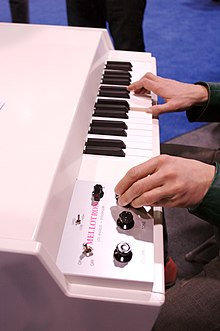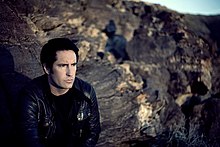Electronics in rock music
The world's first computer to play music was CSIRAC in 1950–1, designed and built by Trevor Pearcey and Maston Beard and programmed by mathematician Geoff Hill.
[4] The Mellotron, an electro-mechanical, polyphonic sample-playback keyboard, which used a bank of parallel linear magnetic audio tape strips to produce a variety of sounds enjoyed popularity from the mid-1960s.
[11] In the last decade a number of software-based virtual studio environments have emerged, with products such as Propellerhead's Reason, Ableton Live and Native Instruments Reaktor finding widespread appeal.
[12] Such tools provide viable and cost-effective alternatives to typical hardware-based production studios, and thanks to advances in microprocessor technology, it is now possible to create high quality music using little more than a single laptop computer.
[16] The Mellotron was used by multi-instrumentalist Graham Bond from 1965[17] and soon adopted by Mike Pinder of The Moody Blues from 1966 on songs including "Nights In White Satin" and by The Beatles from "Strawberry Fields Forever" (1967).
[22] Micky Dolenz of The Monkees bought one of the first Moog synthesizers and the band was 3rd to feature it on an album (behind The Zodiac: Cosmic Sounds and Strange Days) with Pisces, Aquarius, Capricorn & Jones Ltd. in 1967, which reached number 1 on the US charts.
Instrumental prog rock was particularly significant in continental Europe, allowing bands like Kraftwerk, Tangerine Dream, Can, Faust and Klaus Schulze to circumvent the language barrier.
[30] Osamu Kitajima's 1974 progressive psychedelic rock album Benzaiten, featuring Haruomi Hosono, utilized a synthesizer, rhythm machine, and electronic drums.
The mid-1970s saw the rise of electronic art musicians such as Jean Michel Jarre, Vangelis, and Tomita, who with Brian Eno were a significant influence on the development of new-age music.
[35] The American duo Suicide, who arose from the post-punk scene in New York, utilized drum machines and synthesizers in a strange hybrid between electronics and post punk on their eponymous 1977 album.
[41] 1977 was also the year that Ultravox member Warren Cann purchased a Roland TR-77 drum machine, which was first featured in their October 1977 single release "Hiroshima Mon Amour".
The ballad arrangement, metronome-like percussion and heavy use of the ARP Odyssey synthesizer was an early attempt to fuse traditional rock with the new musical technology.
[42] The Japanese band Yellow Magic Orchestra pioneered synthpop with their self-titled album (1978) and Solid State Survivor (1979),[43] with the latter including several early computerized rock songs,[44][45] such as a mechanized cover version of The Beatles' "Day Tripper" (1965).
Others were soon to follow, including Tubeway Army, a little known outfit from West London, who dropped their punk rock image and jumped on the band wagon, topping the UK charts in the summer of 1979 with the single "Are Friends Electric?".
This prompted the singer, Gary Numan to go solo and in the same year he released the Kraftwerk inspired album, The Pleasure Principle and topped the charts for the second time with the single "Cars".
[10] This resulted in a massive increase in the amount of home-produced electronic music available to the general public via the expanding internet,[54] and new forms of performance such as laptronica[10] and live coding.
Indietronica, which had begun in the early '90s with bands like Stereolab and Disco Inferno, took off in the new millennium as the new digital technology developed, with acts including Broadcast from the UK, Justice from France, Lali Puna from Germany and The Postal Service and Ratatat from the US, mixing a variety of indie sounds with electronic music, largely produced on small independent labels.
It was pioneered by I-F with his track "Space Invaders Are Smoking Grass" (1998),[57] and pursued by artists including Felix da Housecat,[58] Peaches, Chicks on Speed[59] and Fischerspooner.







